Bennemann K.H., Ketterson J.B. Superconductivity: Volume 1: Conventional and Unconventional Superconductors; Volume 2: Novel Superconductors
Подождите немного. Документ загружается.

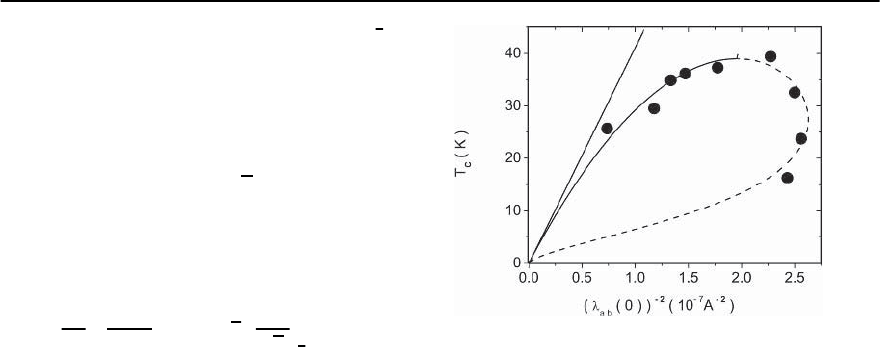
11 Universal Properties of Cuprate Superconductors 479
tent with the scaling relation d
c
/dT
T=0
∝ ı
(
D−2z
)
(see (11.46)). Indeed at 2D–QSI criticalitywith z =1,
d
c
/dT
T=0
tends to a constant value and diverges
close tothe3D–QSNcriticalpointfor z > 3/2.Unfor-
tunately, the data does not extend sufficiently close
to the overdoped limit to provide reliable estimates
of the exponent combination
(
3−2z
)
.
Provided that the linear T-term of 1/
2
ab
(
T
)
in the
zero temperature limit exists, the scaling relations
(11.38) and (11.38) yield close to quantum criticality
the universal relation
T
c
d
dT
i
(0)
i
(T)
2
T=0
= y
c
dY
D
dy
y=0
, (11.79)
where D =2andD = 3 for the 2D–QSI and
3D–QSN transition, respectively. In Table 11.1 we
collected additional estimates for various cuprates
and doping levels. The rise of the magnitude
of T
c
d/dT
(
ab
(ı, 0)/
i
(ı, T)
)
2
T=0
with increasing
doping level reflects the 2D–3D-crossover in the scal-
ing function Y
D
. Noting that most compounds are
close to optimum doping it is not surprising that the
listed values scatter around –0.61,the value of nearly
optimally doped La
2−x
Sr
x
CuO
4
.
Before turning to the substitutiontuned quantum
transitions it is useful to express the doping depen-
dence in the interpolation formula (11.77) in terms
of the transition temperature. This is achieved by
invoking the empirical correlation 11.2 between T
c
and doping concentration x. In Fig. 11.22 we dis-
played the resulting Uemura plot, T
c
versus 1/
2
ab
(
0
)
for La
2−x
Sr
x
CuO
4
in terms of the solid and dashed
curves, resembling the outline of a fly’s wing. The
solid curve marks the flow from T
c
(
x
m
)
to the 2D–
QSI critical point and the dashed one the flow to
3D–QSN criticality.Thedotted line indicates the uni-
versal 2D-behavior (see (11.40)) and (11.68)). For
comparison we included the experimental data of
Panagopoulos et al. [9] and Uemura et al. [83]. Al-
though the data does not attain the respective crit-
ical regimes, together with the theoretical curves,
they provide a generic perspective of the flow to 2D–
QSI and 3D–QSN criticality.Indeed, convincing evi-
dence forthese flows emerges from the SR data dis-
played in Fig. 11.23 for Y
0.8
Ca
0.2
Ba
2
(Cu
1−y
Zn
y
)O
7−ı
(Y
0.8
Ca
0.2
-123), Tl
0.5−y
Pb
0.5+y
Sr
2
Ca
1−x
Y
x
Cu
2
O
7
(Tl-
Fig. 11.22. T
c
versus 1/
2
ab
(
0
)
for La
2−x
Sr
x
CuO
4
. •:experi-
mental data taken from [9,83].The solid and dashed curves
result from the empirical law (11.2) and the interpolation
function (11.77) with T
c
(
x
m
)
= 39.8 K and the parameters
listed in (11.78). The solid line indicates the flow from op-
timum doping to 2D–QSI criticality and the dashed line to
the 3D–QSN critical point
1212) [103] and TlBa
2
CuO
6+ı
(
Tl-2201
)
[104]. In
analogy to Fig. 11.22,the solid curves mark the flow
from T
c
(
x
m
)
to the 2D–QSI critical point and the
dashed curves the approach to 3D–QSN criticality.
Additional confirmation of thisflow emerges from
Fig. 11.24, showing the condensation energy versus
hole concentration p for Y
0.2
Ca
0.2
Ba
0.2
Cu
3
O
7−ı
taken
from Tallon and Loram [105]. The solid and dashed
curves are (11.51), in terms of
−E
(
T =0
)
∝ ı
(z+D
)
/z
∝
p − p
u
3
∝ T
3
c
,
−E
(
T =0
)
∝
p
o
− p
5/2
∝ T
5/2
c
, (11.80)
with
(
z + D
)
/z =3and
(
z + D
)
/z =5/2, the values
appropriate for the 2D–QSI (see (11.65)) and 3D–
QSN (see (11.67)), respectively.
A generic flow to the 2D–QSI critical point also
emerges from the plot
c
(
0
)
versus
c
T
+
c
displayed
in Fig. 11.25 for YBa
2
Cu
3
O
7−ı
,La
2−x
Sr
x
CuO
4
and
Bi
2
Sr
2
CaCu
2
O
y
at various doping levels. An empir-
ical, nearly linear, correlation between these quan-
tities has been proposed by Basov et al. [106]. From
the scaling relation (11.58) it can be seen that the sys-
tematic rise of
c
(
0
)
with decreasing
c
T
+
c
,tuned
by decreasing dopant concentration and the asso-
ciated rise of the anisotropy
T
,againreflectsthe
flow to 3D–QSI criticality. The straight line marks
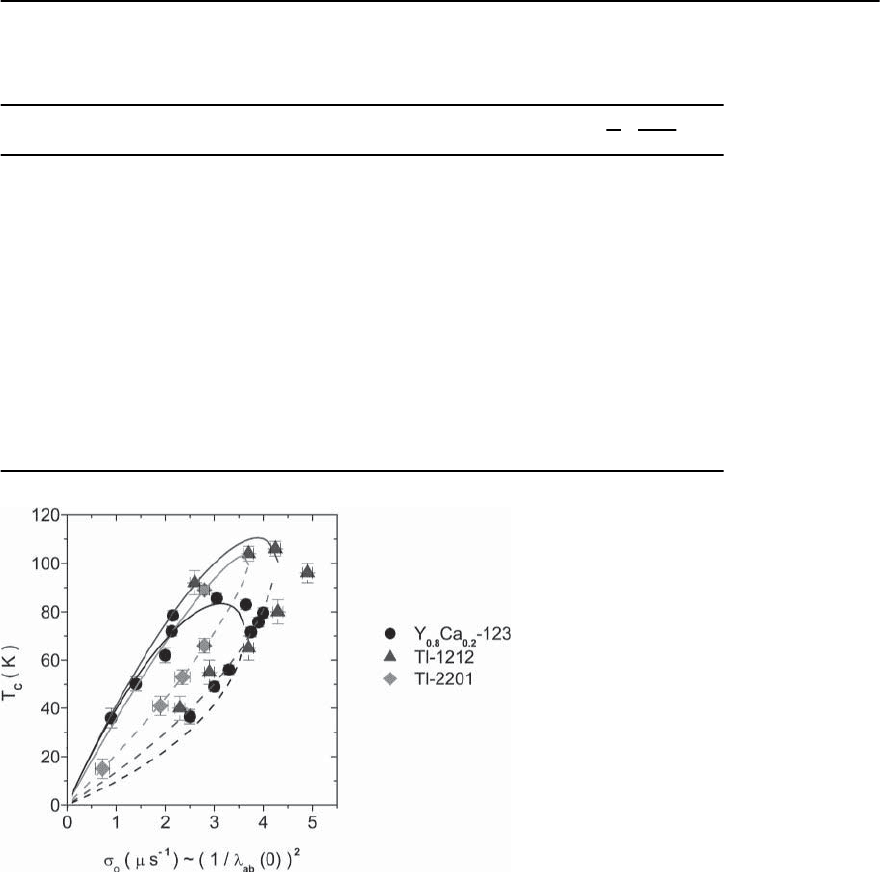
480 T. Schneider
Table 11.1. Estimates for T
c
d/dT
(
ab
(
0
)
/
ab
(
T
))
2
T=0
derived from the experimental data of: slightly underdoped
HgBa
2
Ca
2
Cu
3
O
8+ı
, slightly overdoped HgBa
2
CuO
4+ı
[100], under-, optimally- and over-doped La
2−x
Sr
x
CuO
4
[9],
Bi
2
Sr
2
CaCu
2
O
8+ı
[101],Y
0.94
Ca
0.6
Ba
2
Cu
4
O
8
,YBa
2
Cu
4
O
8
,Y
1.925
La
0.075
Cu
4
O
8
and Y
1.9
La
0.1
Cu
4
O
8
[102]
ab
(
0
)
(A) T
c
(K) T
c
d
dT
i
(ı,0)
i
(ı,T)
2
T=0
HgBa
2
Ca
2
Cu
3
O
8+ı
1770 135 –0.59
HgBa
2
CuO
4+ı
1710 93 –0.65
La
1.9
Sr
0.1
CuO
4
2800 30 –0.49
La
1.85
Sr
0.15
CuO
4
2600 39 –0.61
La
1.8
Sr
0.2
CuO
4
1970 35 –0.72
La
1.78
Sr
0.22
CuO
4
1930 27.5 –0.72
La
1.76
Sr
0.24
CuO
4
1940 19 –0.94
Bi
2
Sr
2
CaCu
2
O
8+ı
2600 91 –0.61
Y
0.94
Ca
0.06
Ba
2
Cu
4
O
8
1361 88 –0.51
YBa
2
Cu
4
O
8
1383 81 –0.58
YBa
1.925
La
0.075
Cu
4
O
8
1521 74 –0.61
YBa
1.9
La
0.1
Cu
4
O
8
1593 72 –0.63
Fig. 11.23. T
c
versus
0
∝
−2
ab
(
0
)
for Y
0.8
Ca
0.2
Ba
2
(Cu
1−y
Zn
y
)O
7−ı
(Y
0.8
Ca
0.2
-123),
Tl
0.5−y
Pb
0.5+y
Sr
2
Ca
1−x
Y
x
Cu
2
O
7
(Tl-1212) [103]
and TlBa
2
CuO
6+ı
(Tl–2201) [104].
The solid and dashed curves result from the em-
pirical law (11.2) and the interpolation function
(11.77). The solid curves indicate the flow from
optimum doping to 2D–QSI criticality and the
dashed curves to the 3D–QSN critical point
the asymptotic behavior La
2−x
Sr
x
CuO
4
for z =1and
§
s
≈ 24m(§cm)
3/4
.Since§
s
depends on the crit-
ical amplitudes
0,0
,
ab,0
(
0
)
,
T
c
,0
and the thickness
d
s
((11.58) and (11.59)), its value is unique within
afamilyofcuprates.§
s
≈ 24m(§cm)
3/4
follows
from
0,0
≈ 1.63,
T
c
,0
≈ 2 (see Fig. 11.1), d
s
≈ 6.6A,
0
≈ 1and
ab,0
(
0
)
≈ 736 A (see (11.78). Al-
though the experimental data is still quite far from
the underdoped limit, the flow to 2D–QSI criticality
with family-dependent values of §
s
can be antici-
pated. This differs from the mean-field prediction
for bulk superconductors in the dirty limit and lay-
ered BCS superconductors,treated as weakly coupled
Josephson junctions (see (11.60) and (11.61)), where
§
s
∝ T
−1/2
c
. Moreover, as the optimally doped and
underdoped regimes are approached, systematic de-
viations from the straight line behavior appear,indi-
cating the flow to 3D–QSN criticality (see (11.63)).
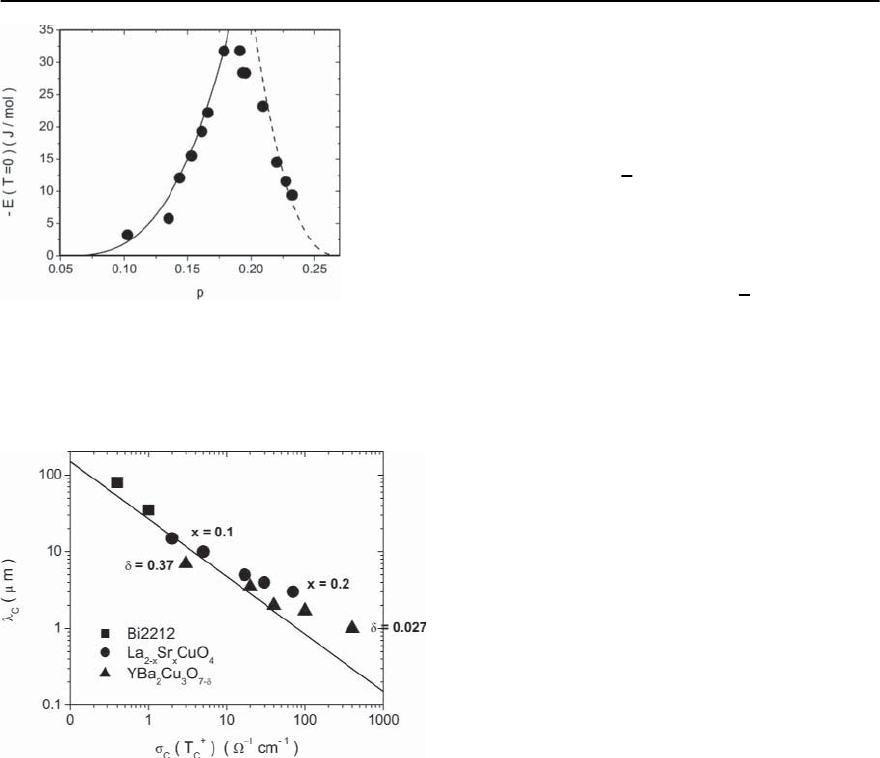
11 Universal Properties of Cuprate Superconductors 481
Fig. 11.24. Condensation energy −E
(
T =0
)
versus hole
concentration p for Y
0.2
Ca
0.2
Ba
0.2
Cu
3
O
7−ı
. The experimen-
tal data is taken from Tallon and Loram [105]. The solid
and dashed lines are (11.80), indicating the approach to
2D–QSI and 3D–QSN criticality
Fig. 11.25.
c
(
0
)
versus
c
T
+
c
for YBa
2
Cu
3
O
7−ı
(),
La
2−x
Sr
x
CuO
4
(•) [107] and Bi
2
Sr
2
CaCu
2
O
y
() [108].The
straight line is (11.58)with z =1and§
s
≈ 24m
(
§cm
)
3/4
,
theestimateforLa
2−x
Sr
x
CuO
4
According to the empirical correlation between
T
c
and anisotropy
T
(see (11.3 and Fig. 11.2), the
initial value of the dopant concentration determines
whether the flow leads to 2D–QSI or 3D–QSN criti-
cality. For initially underdoped cuprates, the rise of
T
, tuned by the doping induced reduction of T
c
,di-
rects the flow to 2D–QSI criticality. Conversely, in
initially overdoped cuprates, the fall of
T
to a finite
value drives the flow to the 3D–QSN critical point.As
the nature of the quantum phase transitions is con-
cerned we have seen that the 2D–QSI transition has
a rather wide and experimentally accessible critical
region.For this reason we observed considerable and
consistent evidence that it falls into the same univer-
salityclassastheonsetofsuperfluidityin
4
He films in
disordered media, corrected for the long-rangeness
of the Coulomb interaction.The resulting criticalex-
ponents, z =1and
≈ 1, are also consistent with
the empirical relations ((11.2),(11.2) and (11.3)) and
the observed temperature and magnetic field depen-
dence of the specific heat coefficient in the limit of
zero temperature. These properties also point to a
3D–QSN transition with z =2and
≈ 1/2, describ-
ing a d-wave superconductor to disordered metal
transition at weak coupling. Here the disorder de-
stroys superconductivity, while at the 2D–QSI tran-
sition it localizes the pairs and destroys superfluidity.
Due to the existence of the 2D–QSI and 3D–QSN crit-
icalpoints,thedetectionof finitetemperature3D–XY
critical behavior will be hampered by the associated
crossovers that reduce the temperature regime where
thermal 3D–XY fluctuations dominate. In any case,
our analysis clearly revealed that the universality of
the empirical correlations reflect the flow to 2D–QSI
and 3D–QSN criticality.Moreover, the doping tuned
superconductivity in bulk cuprate superconductors
turned out to be a genuine 3D phenomenon, where
the interplay of anisotropy and superconductivity
destroys the latter in the 2D limit.
11.3.3 Evidence for Substitution Tuned Quantum
Phase Transitions
It has been well established, both experimentally
and theoretically,that in conventional superconduc-
tors (e.g., A15 compounds or the Chevrel phases)
the presence of magnetic impurities depresses the
superconducting transition temperature more effi-
ciently than does the introduction of nonmagnetic
ions [109], and this has been ascribed to the break-
ing of pairs by the magnetic impurities.To determine
whether the cuprates behave similarly with respect to
magnetic impurities, extensive studies involving the
substitutionforCu by other 3d metals have been per-
formed [18,19].A result common to all these studies
is that T
c
is depressed in the same manner, indepen-
dent of whether the substituent is magnetic or non-
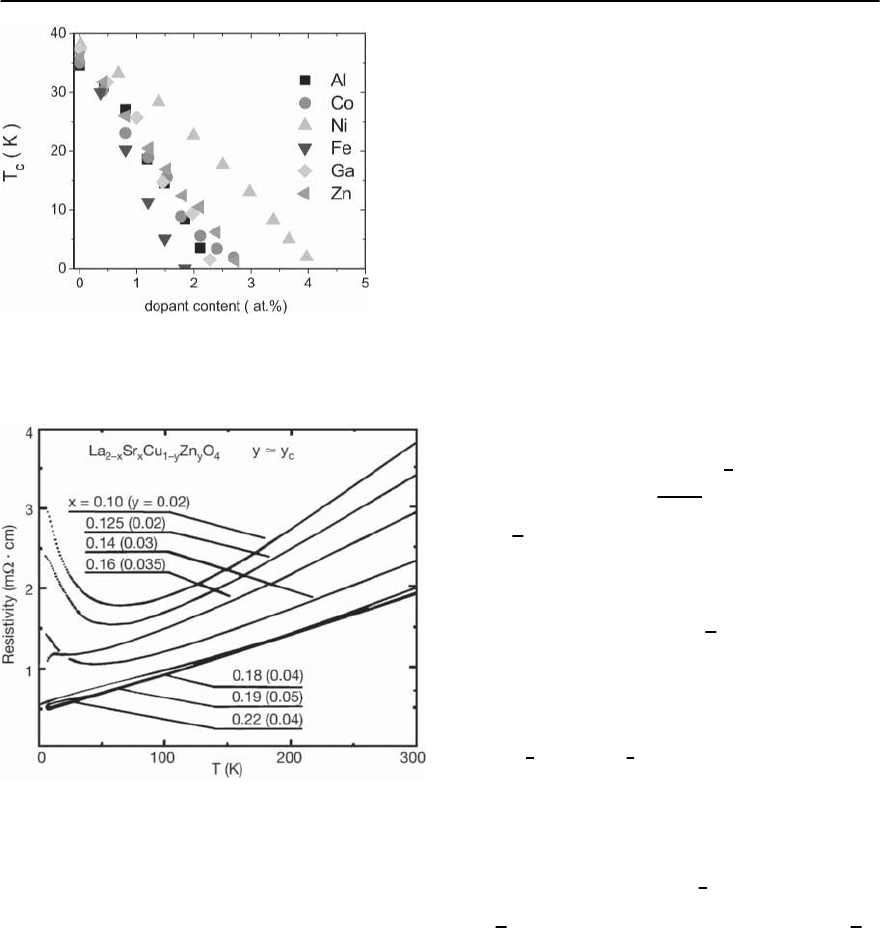
482 T. Schneider
Fig. 11.26. Variat ion of T
c
with substitution for
La
1.95
Sr
0.15
Cu
1−y
A
y
O
4
(A=Fe,Cu,Ni,Zn,GaandAl)(taken
from Xiao et al. [18])
Fig. 11.27. Temperature dependence of the resistivity for
La
2−x
Sr
x
Cu
1−y
Zn
y
O
4
at y
c
(
x
)
(taken from Momono et
al.[15])
magnetic, and in contrast to that observed in con-
ventional superconductors.
To illustrate this point in Fig. 11.26 we de-
picted the variation of T
c
with substitution for
La
1.95
Sr
0.15
Cu
1−y
A
y
O
4
(A=Fe, Cu, Ni, Zn, Ga and
Al) [18]. T
c
is seen to vanish at a critical substi-
tution concentration y
c
, where a quantum phase
transition occurs. The experimental data for
La
2−x
Sr
x
Cu
1−y
Zn
y
O
4
,Y
0.8
Ca
0.2
Ba
2
Cu
3−3y
Zn
3y
O
7−ı
[110] and Bi
2
Sr
2
CaCu
2−2y
Co
2y
O
8+ı
[111] shows that
this behavior is not restricted to optimum doping.
Thus T
c
depends on both the dopant (x)andsub-
stitution concentration (y). Figure 11.3 shows the
resulting (T
c
, x, y) diagram for La
2−x
Sr
x
Cu
1−y
Zn
y
O
4
.
The blue curve, y
c
(
x
)
, is a line of quantum phase
transitions. At the corresponding critical endpoints
the system undergoes a 2D–QSI and 3D–QSN tran-
sition. Along the path marked by the green arrow,
a QSI and QSN transition is expected to occur. The
pink arrow indicates the crossover from insulating
to metallic behavior.
This scenario,emerging from the temperature de-
pendence of the resistivity of La
2−x
Sr
x
Cu
1−y
Zn
y
O
4
[15], is shown in Fig. 11.27. Along the phase tran-
sition line y
c
(
x
)
superconductivity disappears and
for x 0.16 metallic behavior sets in, while for
x 0.16 the resistivity exhibits insulating behavior
at low temperatures. For fixed x and close to y
c
(
x
)
,
T
c
scales according to (11.33) and (11.38) as
T
c
y
∝
1−
y
y
c
(
x
)
z
. (11.81)
Since z
= 1 is expected to hold in both the doping
tuned 2D–QSI and 3D–QSN transition ((11.65) and
(11.67)), this combination should hold along the en-
tire line y
c
(
x
)
.Although the data shown in Fig. 11.26
is remarkably consistent with z
= 1 it remains to be
understood why the linear relationship applies over
almost the entire substitution regime. Close to the
2D–QSI and 3D–QSN transitions,the singular part of
the free energy density scales in analogy to (11.36) as
f
s
∝ ı
(D+z
)
F
yı
−
, ı = x/x
u
−1, 1−x/x
o
.
(11.82)
F is a scaling function of its argument.A phase tran-
sition is signaled by a singularity of the scaling func-
tion at some value of its argument. Thus,
y
c
(
x
)
∝ ı
, (11.83)
with
= 1 close to the 2D–QSI (see (11.65)) and =
1/2 near the 3D–QSN transition(see (11.67)).There-
sulting phase transitionline is shown in Fig.11.28for
La
2−x
Sr
x
Cu
1−y
Zn
y
O
4
, where we included the experi-
mental data for comparison. As expected from the
doping dependence of the correlation lengths (see
Fig. 11.20) close to the 3D–QSN transition y
c
(
x
)
ex-
hibits a very narrow critical regime. For this reason
the data considered here is insufficient to provide an
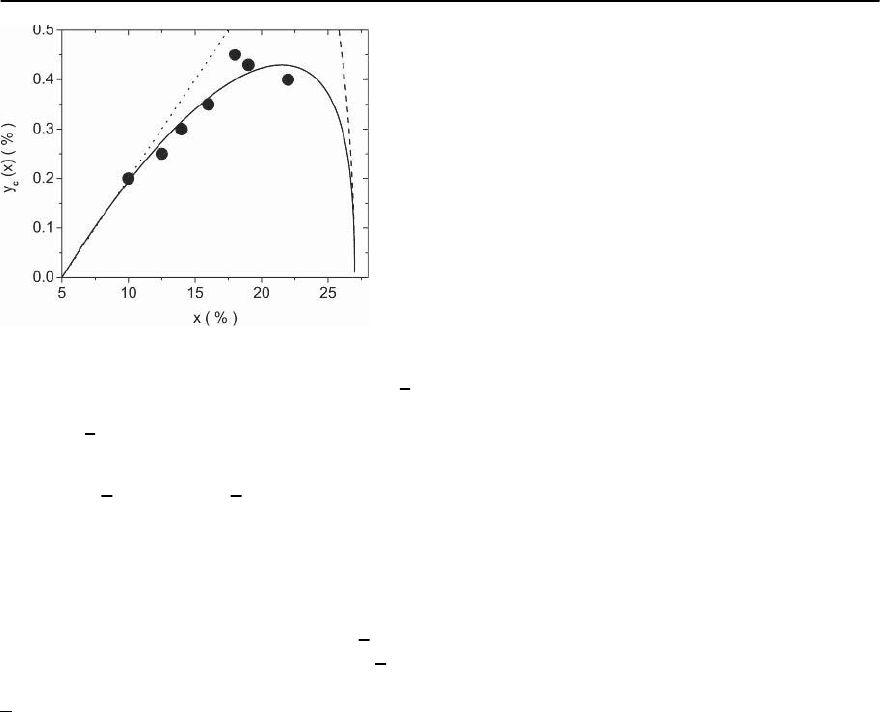
11 Universal Properties of Cuprate Superconductors 483
Fig. 11.28. y
c
versus x for La
2−x
Sr
x
Cu
1−y
Zn
y
O
4
. • :Taken
fromMomono etal.[15].Thesolid curve interpolates be-
tween the critical behavior of a 2D–QSI transition with
=
1(dotted line: y
c
(
x
)
=0.03
(
x −5
)
)anda3D–QSNtran-
sition with
=1/2(dashed line: y
c
(
x
)
=0.46
(
27 − x
)
1/2
)
estimate for . Nevertheless, =1/2yieldsareason-
able qualitative description of the quantum critical
line y
c
(
x
)
.
The picture we now have is summarized in the
phase diagram shown in Fig. 11.3. The blue curve
corresponds to the line of quantum phase transitions
y
c
(
x
)
shown in Fig. 11.28. Along this line, z
=1is
expected to hold ((11.65) and (11.67)), while
≈ 1
(see (11.65)) at the 2D–QSI (y =0andx = x
u
)and
=1/2atthe3D–QSN((y =0andx = x
o
) transi-
tion. According to the empirical correlation between
T
c
and anisotropy
T
(see (11.3) and Fig. 11.2), the
initial value of the dopant concentration determines
whether the flow upon substitution leads to 2D–
QSI or 3D–QSN criticality. For initially underdoped
cuprates, the rise of
T
,tuned by the substitution in-
duced reduction of T
c
,drives the flow to2D–QSI crit-
icality. Conversely, in initially overdoped cuprates,
the fall of
T
to a finite value directs the flow to 3D–
QSN criticality.The mechanism whereby the substi-
tution of Cu leads to a reduction of T
c
and finally
to the quantum critical line y
c
(
x
)
appears to be not
well understood. When the aforementioned univer-
sality classes of the 2D–QSI and 3D–QSN transitions
hold true ((11.65) and (11.67)), disorder plays an es-
sential role.At 2D–QSI criticalityit localizes the pairs
anddestroyssuperfluidity [52,53] andat the3D–QSN
transition it destroys superfluidity and the pairs [54].
In this context we also note that the phase diagram
of La
2−x
Sr
x
CuO
4+ı
shown in 11.4,revealsthat isotope
substitutionleads to identicalbehavior,although less
pronounced (taken from unpublished work of Guo-
Meng Zhao et al.. Since isotope substitution is ac-
companied by local lattice distortions, we conclude
that in addition to disorder, lattice degrees of free-
dom tune superconductivity in an essential man-
ner. Another essential facet emerges from the fact
that the doping and substitution tuned flow to the
2D–QSI critical point is associated with an enhance-
ment of
T
. Thus, despite the fact that the fraction
=
1/
2
c
(
0
)
/
1/
2
a
(
0
)
+1/
2
b
(
0
)
+1/
2
c
(
0
)
=
1/
1+2
2
T=0
[13], which the third dimension con-
tributes to the superfluid energy density in the
ground state, is very small, this implies that a finite
T
c
is inevitablyassociated with an anisotropicbut3D
condensation mechanism, because
T
is finite when-
ever superconductivity occurs (see Fig. 11.2). This
points unambiguously to the conclusion that theo-
ries formulated fora single CuO
2
plane cannot be the
whole story. It does not imply, however, a 3D pairing
mechanism because in the presence of fluctuations
pairing and superfluidity occur separately.
11.3.4 Evidence for Magnetic Field Tuned Quantum
Phase Transitions
We have seen (Sect. 11.2) that a strong magnetic field
destroys superconductivity at finite temperature. In
sufficiently clean systems this destruction occurs at
the first-order vortex melting transition. However,
in the presence of disorder, the long-range order of
the vortex lattice is destroyed and the vortex solid
becomes a glass [27]. The vortex fluid to glass transi-
tion appears to be a second-order transition,signaled
by the vanishing of the zero-frequency resistance in
the vortex glass phase. Since disorder plays an es-
sential role at 2D–QSI and 3D–QSN criticality, one
expects a line H
m
(
x
)
of vortex glass to fluid quan-
tum phase transitions,leading to the schematic phase
diagram depicted in Fig. 11.5. There is the supercon-
ducting phase (S), bounded by the zero-field transi-
tion line,T
c
(
x, H =0
)
,the criticallines of the vortex
melting or vortex glass to vortex fluid transitions,
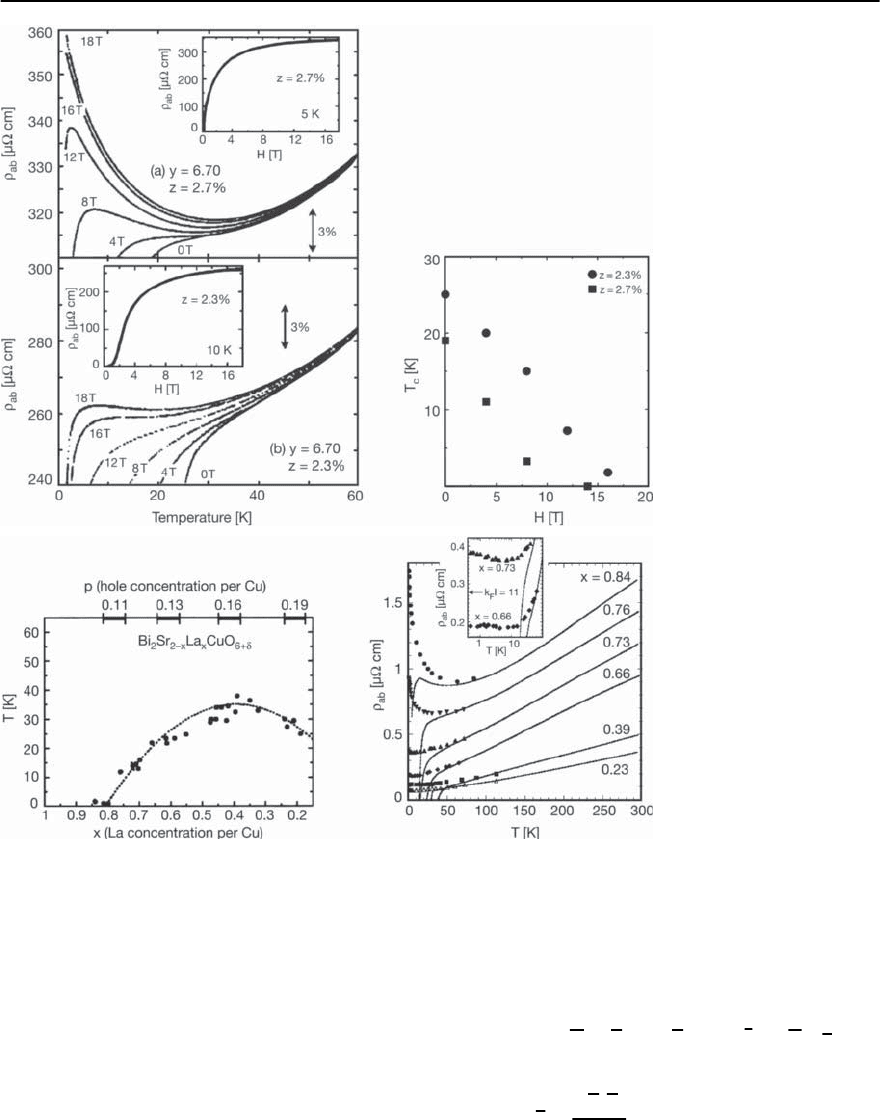
484 T. Schneider
Fig. 11.29. Left panel:In-
plane resistivity
ab
versus
T at H =0, 4, 8, 16 and
18 T for YBa
2
Cu
3−z
Zn
z
O
y
.
a: y =6.7, z =2.7%
and b: y =6.7, z =
2.3%. Taken from Segawa
et al. [30]. Right panel:
Schematic (H, T)-phase di-
agram of YBa
2
Cu
3−z
Zn
z
O
y
derived from the data
shownintheleft panel
Fig. 11.30. Left panel:PhasediagramofBi
2
Sr
2−x
La
x
CuO
6+ı
in the doping concentration (x or p)-temperature plane. Taken
from Ono et al. [31]. Right panel: Temperature dependence of
ab
for a Bi
2
Sr
2−x
La
x
CuO
6+ı
crystal in H =0and60Tfor
various dopant concentrations x.Theinset shows a clearer view of the low temperature behavior for x =0.66 and 0.73
(taken from Ono et al. [31])
T
m
x = fixed, H
and the line of quantum critical
points, H
m
(
x, T =0
)
. Along this line superconduc-
tivity is suppressed and the critical endpoints coin-
cide with the 2D–QSI and 3D–QSN critical points
at x
u
and x
o
, respectively. To fix the critical line
H
m
(
x, T =0
)
close to the 2D–QSI and 3D–QSN tran-
sitions, we note that the singular part of the ground
state energy density scales in analogy to (11.36) as
f
s
(
ı, T
)
=
Q
D
−
,0
D
A
i=1
−
i,0
%
−1
ı
(D+z
)
G
D
(
z
)
,
z =
H
a
b
¥
0
, (11.84)

11 Universal Properties of Cuprate Superconductors 485
where H corresponds to a field applied parallel to the
c-axis. Supposing that in the (H, ı)planethereisa
continuous transition first order melting transition.
Then the scaling function
G
D
(
z
)
will exhibita singu-
larity at some universal value
z = z
m
.Thusclosethe
2D–QSI and 3D–QSN critical endpoints the quantum
critical line (see Fig.11.5) is given by
H
m
(
ı
)
=
z
m
¥
0
a,0
b,0
ı
2
, (11.85)
with
≈ 1 (see (11.65)) and ≈ 1/2 (see (11.67))
close to 2D–QSI and 3D–QSN criticality,respectively.
Moreover, the singular behavior of the scaling func-
tion
G
D
(
z
)
must be such as to enable the correlation
length when H = 0 to correspond to the vortex glass
transition,so that
H
=
H,0
H − H
m
(
ı
)
H
m
(
ı
)
−
m
. (11.86)
m
is the correlation length exponent of the vortex
glass to fluid transition. Noting that T
c
∝ ı
z
∝
−z
(see (11.34) and (11.38), with (11.86) we obtain for
the magnetic field induced reduction of T
c
the rela-
tion
T
c
(
H
)
∝
(
H
m
(
ı
)
− H
)
m
z
m
. (11.87)
z
m
isthedynamic criticalexponentof the vortexglass
to fluid transition.
The existence of a quantum phase transition line
H
m
(
ı
)
can be anticipated from the in-plane re-
sistivity data for YBa
2
Cu
3−z
Zn
z
O
y
of Segawa et al.
[30] shown in the left panel of Fig. 11.29. With in-
creasing magnetic field strength T
c
is depressed.
In the sample with y =6.7andz =2.7% the
temperature dependence of
ab
clearly points to a
magnetic field tuned QSI transition around 16 <
H
m
y =6.7, z =2.7%
18T.SinceH
m
(
ı
)
scales as
ı
2
∝
(
z
c
− z
)
2
(see (11.85)), H
m
y =6.7, z
should
increase with reduced Zn concentration z.Thisbe-
havior is consistent with the data for z =2.3%,where
H
m
y =6.7, z =2.3%
> 18T. The emerging (H, T)
phase diagram,consistingof finite temperature tran-
sition lines (vortex glass to fluid transitions) with
2D–QSI critical endpoints is displayed in the right
panel of Fig. 11.29. In the schematic (x, H, T)-phase
diagram shown in Fig. 11.5, these lines result from
cuts near the zero field 2D–QSI transition with x re-
placed by z.
Related behavior was also observed in
La
2−x
Sr
x
CuO
4
[29] and Bi
2
Sr
2−x
La
x
CuO
6+ı
[31]. In
the hole doped La
2−x
Sr
x
CuO
4
[29] and the elec-
tron doped Pr
2−x
Ce
x
Cu
4+ı
a magnetic field tuned
metal to insulator crossover was observed close to
optimum doping, while in Bi
2
Sr
2−x
La
x
CuO
6+ı
[31]
the crossover sets in well inside the underdoped
regime. The phase diagram of Bi
2
Sr
2−x
La
x
CuO
6+ı
is
displayed in the left panel of Fig. 11.30. In the under-
doped limit (x ≈ 0.84) the transition temperature
vanishes and a 2D–QSI transition is expected to oc-
cur. Evidence for this transition emerges from the
temperature dependence of
ab
shownintheright
panel of Fig. 11.30 [31], taken at H =0and60T
for six doping levels x. To strengthen this point in
Fig. 11.31 we plotted the resulting T
c
versus
0,c
−
0
for x =0.76, 0.73 and 0.66 and
0,c
≈ 0.5 m§cm
at H = 0. Apparently there is suggestive consis-
tency with the 2D–QSI scaling relation (11.42) with
z
≈ 1, as well as with the corresponding data for
La
2−x
Sr
x
CuO
4
and YBa
2
Cu
3
O
7−ı
shown in Fig. 11.15.
As the 60T data (symbols) are concerned, the sam-
ples closest to the QSI transition (x =0.76 and 0.84)
exhibit a pronounced upturn in
ab
at low temper-
atures.Thispointstoaninsulatingnormalstate.
Indeed, the weak upturn below 6 K at x =0.73, vis-
ible in the inset of Fig. 11.30, signals the proximity
to the onset of insulating behavior, while the low
T behavior of the x =0.66 sample with T
c
(
H =0
)
= 23 K exhibits metallic behavior. Thus, there is
a metal to insulator (MI) crossover. The emerging
(x, T, H)-phase diagram is displayed in Fig. 11.32.
The arrows mark the flows emerging from the ex-
perimental data displayed in Fig. 11.30 for x =0.84
(1) and x =0.66 (2).
This differs from the behavior observed in
La
2−x
Sr
x
CuO
4
where the detectable MI-crossover ap-
pears to set in close to optimum doping.In Fig. 11.33
we depicted the logarithmic plot of
ab
(
T
)
for
Bi
2
Sr
2−x
La
x
CuO
6+ı
and La
2−x
Sr
x
CuO
4
crystals for
H = 0 and 60T and various doping concentrations
[31]. Concentrating on the presence or absence of an
upturn,it is clearly seen that in La
2−x
Sr
x
CuO
4
the MI-

486 T. Schneider
Fig. 11.32. Schematic (x, T, H)-phase diagram
close to the 2D–QSI transition. There is the su-
perconducting phase (S), bounded by the zero-
field transition line, T
c
(
x, H =0
)
,thelines
of the vortex melting or vortex glass to vor-
tex fluid transitions T
m
x = fixed, H
and the
quantum critical line H
m
(
x
)
. The critical lines
T
c
(
x, H =0
)
and H
m
(
x
)
merge in the under-
doped limit (x = x
u
) where a doping driven
quantum superconductor to insulator (QSI)
transition (•)occurs.Thearrows mark the
flows emerging from the experimental data
shown in Fig.11.31 at x =0.84 (1), x =0.66 (2)
Fig. 11.31. T
c
versus
0,c
−
0
for Bi
2
Sr
2−x
La
x
CuO
6+ı
.De-
duced from the data shown in Fig. 11.30 for x=0.76, 0.73
and 0.66 and
0,c
=0.5m§ cm. The straight line is the
scaling relation (11.70) with z
≈ 1
crossover occurs around x ≈ 0.15, corresponding to
optimum doping. However,it should be kept in mind
that this crossover is nonuniversal. For this reason,
the dopant concentration where insulating behavior
is detectable is expected to be material-dependent.
The magneto resistance
ab
(
H, T
)
of underdoped
La
2−x
Sr
x
CuO
4
films with x ≈ 0.048
(
T
c
=0.45K
)
and 0.051
(
T
c
=4K
)
was also studied in mag-
netic fields up to 0.5 T and at temperatures down
to 30mK [112]. The temperature dependence of
ab
(
H, T
)
of the film closest to the 2D–QSI tran-
Fig. 11.33. Logarithmic plot of
ab
(
T
)
for
Bi
2
Sr
2−x
La
x
CuO
6+ı
and La
2−x
Sr
x
CuO
4
crystals in H =0T
(solid lines)and60T(filled circles), labeled by La con-
centration, x.The straight line indicates consistency with
the log(1/T)behavioratx =0.84. and open circles are
H =30Tdata.La
2−x
Sr
x
CuO
4
data in H =0T(dashed
lines)andin60T(open squares),labeled by the Sr concen-
tration x (taken from Ono et al. [31])

11 Universal Properties of Cuprate Superconductors 487
sition
(
x ≈ 0.048, T
c
=0.45K
)
was found to be con-
sistent with
ab
∝ exp
(
T/T
0
)
1/3
below 1 K and for
fields from 4 to 6 T. Thus this study points to 2D-
localization. On the other hand, the data of Ando et
al. [28] (Fig. 11.33) appears to be consistent with a
logarithmic divergence of the normal-state resistiv-
ity down to 0.7K for x =0.08 and H = 60 T, suggest-
ing 2D weak localization. In any case, the evidence
for 2D localization confirms an essential property of
2D–QSI criticality: disorder localizes the pairs and
destroys superfluidity [52,53].
11.4 Thin Films
There is considerable evidence that the quantum su-
perconductor to insulatortransitionin thin films can
also be traversed by changing a parameter such as
film thickness, disorder, etc. [13]. As far as cuprates
are concerned, an instructive example are the mea-
surements of YBa
2
Cu
3
O
7−ı
slabs of thickness d sep-
arated by 16 unit cells (≈ 187 A) of PrBa
2
Cu
3
O
7
.Due
to the large separation the YBa
2
Cu
3
O
7−ı
slabs can
be considered to be essentially to be uncoupled. As
shown in Fig. 11.6 in YBa
2
Cu
3
O
7−ı
slabs of thick-
ness d the transition temperature was found to vary
according to (11.4). Together with the scaling rela-
tion (11.38) this points to a 2D–QSI transition with
z
= 1, in agreement with our previous estimate
(see (11.65)). Since quantum fluctuations alone are
not incompatible with superconductivity, this 2D–
QSI transition must be attributed to the combined
effect of disorder and quantum fluctuations. Never-
theless, it is conceivable that in cleaner films super-
conductivity may also occur at and below this value
of d
s
, which is close to the estimate derived from the
bulk (see (11.69)).What is seen is then superconduc-
tivity in 2D and due to the reduced dimensionality
fluctuations will be enhanced over the full range of
dopant concentrations.As it stands, in the bulk (see,
e.g. Fig. 11.2) and chemically doped films supercon-
ductivity disappearsin the2D-limit.Sincechemically
doped materials with different carrier densities also
have varying amounts of disorder, the third dimen-
sion is apparently needed to delocalize the carriers
and to mediate superfluidity.
11.5 Concluding Remarks and Comparison
with Other Layered Superconductors
Evidence for power laws and scaling should prop-
erly consist of data that cover several decades in the
parameters. The various power laws that we have ex-
hibited span at best one decade and the evidence for
data collapse exists only over a small range of the
variables. Consequently, though the overall picture
of the different types of data is highly suggestive,
it cannot really be said that it does more than in-
dicate consistency with the scaling expected near a
quantum critical point or a quantum critical line.
Nevertheless, the doping, substitution and magnetic
field induced suppression of T
c
clearly reveal the ex-
istence and the flow to 2D–QSI and 3D–QSN quan-
tum phase transition points and lines (see Figs. 11.1,
11.2, 11.3 and 11.5). In principle, their universal crit-
ical properties represent essential constraints for the
microscopic theory and phenomenological models.
As it stands, the experimental data is fully consis-
tent with a single complex scalar order parameter,
a doping induced dimensional crossover, a doping,
substitution or magnetic field driven suppression of
superconductivity, due to the loss of phase coher-
ence. When the evidence for this scenario persists,
antiferromagnetic and charge fluctuationsare irrele-
vant close to criticality. Moreover, given the evidence
for the flow to 2D–QSI criticality, the associated 3D–
2D crossover,tunedby increasing anisotropy,implies
that a finite T
c
and superfluid density in the ground
state of bulk cuprates is unalterably linked to a fi-
nite anisotropy. This raises serious doubts that 2D
models are potential candidates to explain supercon-
ductivity in bulk cuprates. Thus, there is convinc-
ing evidence that the combined effect of disorder
and quantumfluctuationsplays an essential role and
even destroys superconductivity in the 2D limit of
chemically doped cuprates. Thus, as far as the na-
ture of the quantum phase transitions in chemically
doped cuprates is concerned, disorder is an essen-
tialingredient.Wehaveseenthatthe2D–QSItransi-
tion has a rather wide and experimentally accessible
critical region. For this reason we observed consid-
erable and consistent evidence that it falls into the
same universality class as the onset of superfluid-

488 T. Schneider
ity in
4
He films in disordered media, corrected for
the long-rangeness of the Coulomb interaction. The
resulting critical exponents, z =1and
≈ 1are
also consistent with the empirical relations ((11.2),
(11.2) and (11.3)) and the observed temperature and
magnetic field dependence of the specific heat coef-
ficient in the limit of zero temperature. These prop-
erties also point to a 3D–QSN transition with z =2
and
≈ 1/2, describing a d-wave superconductor to
disordered metal transition at weak coupling. Here
the disorder destroys superconductivity, while at the
2D–QSI transition it localizes the pairs and destroys
superfluidity.Due to the existence of the 2D–QSI and
3D–QSN critical points, the detection of finite tem-
perature 3D–XY critical behavior will be hampered
by the associated crossovers that reduce the tem-
perature regime where thermal 3D–XY fluctuations
dominate. In any case, our analysis clearly revealed
that superconductivity in chemically doped cuprate
superconductors is a genuine 3D phenomenon and
that the interplay of disorder (anisotropy) and su-
perconductivity destroys the latter in the 2D limit.As
a consequence, the universality of the empirical cor-
relations reflects the flow to 2D–QSI and 3D–QSN
criticality, tuned by chemical doping, substitution
and an applied magnetic field. A detailed account
of the flow from 2D–QSI to 3D–QSN criticality is
a challenge for microscopic theories attempting to
solve the puzzle of superconductivity in these mate-
rials. Although the mechanism for superconductiv-
ity in cuprates is not yet clear, essential constraints
emerge from the existence of the quantum critical
endpoints and lines. However, much experimental
work remains to be done to fix the universality class
of the 2D–QSI and particularly of the 3D–QSN criti-
cal points unambiguously.
In conclusion we note that universal properties
emerging from thermal and quantum fluctuations
are not restricted to cuprate superconductors. Po-
tential candidates are the highly anisotropic organic
Fig. 11.34.
c
(
0
)
versus
DC
c
for a variety of superconductors. YBa
2
Cu
3
O
7−ı
(YBCO) [114–118], La
2−x
Sr
x
CuO
4+ı
(LSCO)
[116,119, 120], HgBa
2
CuO
4+ı
(Hg1201) [121], Tl
2
Ba
2
CuO
6+ı
(Tl2201) [122–124], Bi
2
Sr
2
CaCu
2
O
8+ı
(Bi2212) [125, 126],
Nd
2−x
Ce
x
CuO
4+ı
(NCCO) [127]. Blue points: underdoped (UD), green points: optimally doped (OpD) and red points:
overdoped (OD). Transition metal dichalcogenides [144,145]; (ET)
2
X compounds [135–143]; (TMTSF)
2
ClO
4
[128–134];
Sr
2
RuO
4
[146,147];MgB
2
[148–150]; Nb [151,152]; Pb [152]; Nb Josephson junctions [153]; ˛Mo
1−x
Ge
x
[154]. The dotted
line is (11.88) and the dashed lines (11.58). The red arrows indicate the flow to 2D–QSI and for overdoped YBa
2
Cu
3
O
7−ı
to 3D–QSN criticality, respectively
